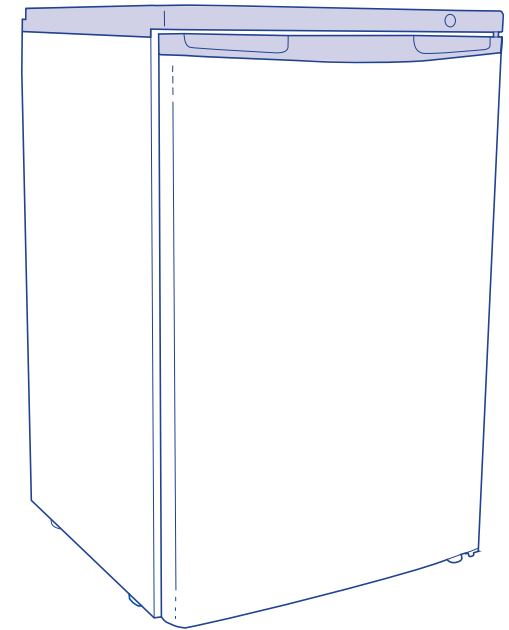User Manual
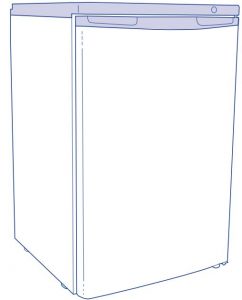
Fridgemaster MUZ5580 Freestanding Under Counter Freezer
GETTING TO KNOW YOUR FREEZER
Before usePlease read these instructions carefully before using your new Fridgemaster Freezer The Freezer is for indoor, domestic use only. Please keep these instructions in a safe place for future reference.
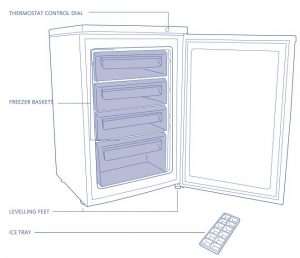
INSTALLATION
LocationWhen selecting a position for your Freezer you should make sure the floor is flat and firm, Av oid locating your freezer near a heat source, eg. cooker, boiler or radiator. Also avoid direct sunlight . When your Freezer is working, the sides may become warm. It must therefore be installed so there is 2 at least 75mm ( 3″) seperating the back of the freezer to the wall, at least 100mm (3.9″) of space on both sides, height over 100mm (3.9″) from its top and clear space infront to all ow the door to open, 60°. The Freezer door can either open to the right or the left, depending on the location which suits you. See page 6 if you want to reverse the door swing.Do not drape the Freezer with any covering.
Levelling the FreezerOnce the Freezer is put in it’s final location, make sure it is level. To do this use the two levelling feet at the front of the Freezer. If the Freezer is not level, the doors and magnetic seal alignment will be affected.
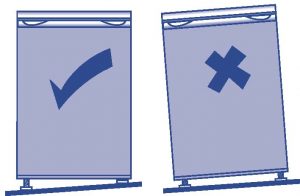
Cleaning before useWipe the inside of the Freezer with a weak solution of bicarbonate of soda. Then rinse with warm water using a ‘wrung-out’ sponge or cloth. Wipe com pletely dry before replacing the shelves and baskets. You could clean the Freezer externally with wax polish. If you require more information refer to CLEANING on page 7.
Before plugging in YOU MUSTCheck that you have a socket w hich is compatible w ith the plug supplied with the Freezer.If not, see the section called ELECTRICAL CONNECTIONS on page 11 .
USING YOUR FREEZER
Set the Thermostat Control Dial to NORMAL for everyday operation and check that the Freezer compartment is cold before placing food in the Freezer.
Is the Freezer cold enough?If you are concerned that your Freezer is not being kept cold enough, and wish to check the temperature, you will need a special fridge / freezer thermometer available from most supermarkets and hardware shops.
Place the thermometer in the middle basket of the Freezer, where it can be read easily. Leave overnight, the temperature in the Freezer should be -18 ° C or lower.

Adjusting the temperatureThe internal temperature of your Freezer is controlled by the Thermostat Control Dial on the front of the Freezer. The MAX setting lowers the temperature inside the Freezer compartment . The NORMAL setting is for everyday operation.
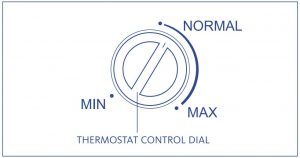
Noises inside the Freezer!If you have not owned a fridge or freezer before, you may notice that it makes some rather unusual noises. Most of these are perfectly normal, but you should be aware of them!
GURGLING, WHOOSHINGThese noises are caused by the circulation of the refrigerant liquid in the cooling system. It has become more pronounced since the introduction of CFC free gases. This is not a fault and will not affect the performance of your Freezer.
HUMMING, PURRING OR PULSATINGThis is the compressor motor working, as it pumps the refrigerant around the system.
Shopping for frozen foodsYour Freezer is 4 star ![]() When you are buying frozen food, look at the Storage Guidelines on the packaging. You will be able to store each item of frozen food for the period shown against the 4 star rating. This is usually the period stated as ‘Best Before’, on the front of the packaging.
When you are buying frozen food, look at the Storage Guidelines on the packaging. You will be able to store each item of frozen food for the period shown against the 4 star rating. This is usually the period stated as ‘Best Before’, on the front of the packaging.
Check the freezer temperatureCheck the temperature of the frozen food cabinet in the shop where you buy your frozen foods. It should show a temperature lower than -18°C.
Choose packs carefullyTake a quick look at the frozen food package and make sure it is inperfect condition.
Purchase frozen food lastAlways buy frozen products last on your shopping trip or visit to thesupermarket.
Keep frozen foods togetherWhen you are going around the supermarket and when you are travelling home, if you keep all the frozen foods together they will help to keep each other cold.
Store food straight away Don’t buy frozen food unless you can freeze it straight away. Special insulated bags can be bought from most supermarkets and hardware shops. These keep frozen food cold for longer.
Thawing frozen foodFor some foods, thawing before cooking is unnecessary. Vegetables and pasta can be added directly to boiling water or steam cooked. Frozen sauces and soups can be put into a saucepan and heated gently until thawed.
To Thaw frozen foods
- Cover food loosely.
- Thaw at room temperature. Don’t forget that thawing in a warm area encourages the growth of bacteria.
- Always make sure there are no ice crystals in the food before cooking, particularly with meat. These crystals indicate that the food is not fully thawed. They result in lower temperatures when cooking. Lower cooking temperatures may not destroy dangerous bacteria.
- Cook food as soon as possible after thawing.
- Drain off and throw away any liquid lost during thawing.
Oven ThawingMany microwaves and ovens have thaw settings. To avoid bacterial build up, only use these if you intend to cook the food immediately afterwards.
Safety Tips
- Never re-freeze anything that has thawed out unless you cook it again, to kill off harmful bacteria
- Never re-freeze thawed shellfish.
Useful Tip
- Re-seal packs properly after removing items. This prevents drying or‘freezer burn’ and a build up of frost on any remaining food.
Freezing fresh foods
Useful tipsUse quality food and handle it as little as possible. Freeze food in small quantities, it freezes faster, takes less time to thaw and enables you to eat it in the quantity you need.
What not to freezeBananas, Pomegranates, Pears or Carbonated liquids.
NOTE: DO NOT STORE INFLAMMABLE GASES OR LIQUIDS
Preparations for freezing
- Leave cooked food to cool completely.
- Chill food in a fridge before freezing if possible.
- Consider how you want to cook the food before freezing it.
- Don’t freeze food in metal containers if you may want to microwave it straight from the freezer.
- Use special freezer bags available from supermarkets, freezer film, polythene bags, plastic containers, aluminium foil (heavy grade only, if in doubt, double wrap). Don’t use aluminium foil for acidic foods (such as citrus fruits). Don’t use thin cling film or glass. Don’t use used food containers (unless cleaned thoroughly first).
- Exclude as much air from the container as possible. You could buy a special vacuum pump which sucks excessive air out of the packaging.
- Leave a small amount of ‘air space’ when freezing liquids, to allow for expansion.
- You can use the space in the freezer most efficiently if you freeze liquids (or solids with liquids, such as stew) in square blocks. This is known as ‘preforming’. Pour the liquid into a polythene bag which is inside a square sided container. Freeze it like this, then remove it from the container and seal the bag.
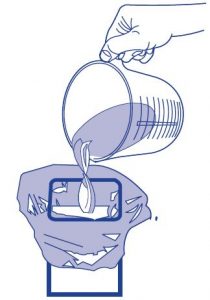
Label everything
- Many foods look the same when frozen, so careful labelling will help avoid forgetting what an item is. Storage times being exceeded could cause food poisoning.
- You can buy special freezer tape for use in low temperatures. This tape is available in white, so you can use it to write the items contents on. You can buy special freezer labels and pens. Labels come in different colours which can help you use your Freezer effectively. For instance you could colour code meat red and vegetables green. Using a different colour label for each quarter of the year will help you rotate your frozen food more efficiently.
- Write the contents and date. If you are really organised add the weight and notes on cooking such as ‘thaw first’, or ‘cook from frozen’ and keep a separate ‘log-book’ of what is in each drawer. This will save opening the door and searching around unnecessarily.
Recommended storage periods(when frozen from fresh)
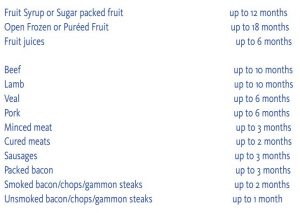
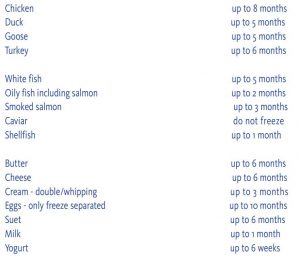
REVERSING THE DOOR SWING
- Ensure the Freezer is unplugged and empty.
- We recommend you have someone to assist you.
Tools required
- Phillips style screwdriver
- Flat bladed screwdriver
- Small adjustable spanner
Before you start lay the Freezer on its back in order to gain access to the base. You should rest it on soft foam packaging or similar material to avoid damaging the cooling pipes at the rear of the Freezer.
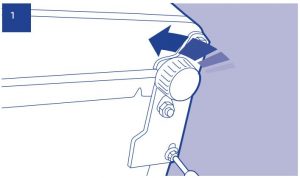
Remove both adjustable feet and remove the bottom hinge bracket by unscrewing the bolts. Support the door to avoid damage.
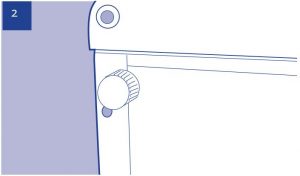
Remove levelling foot from this point and relocate it into available point at opposite front corner.
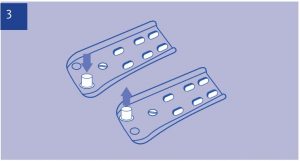
Unscrew and remove the hinge pin and refit it into the adjacent hole. Refit the bracket fitting the hinge pin, spacers and washers into the bushing at the bottom of the door. Replace both adjustable feet.

Stand the Freezer, use a flat bladed screw driver to remove the 2 screw covers at the rear of the Freezer lid.
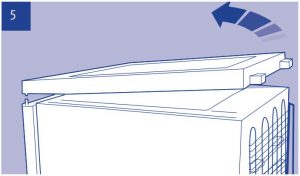
Unscrew and lift the lid of the Freezer from the rear and remove it. Put it in a safe place.
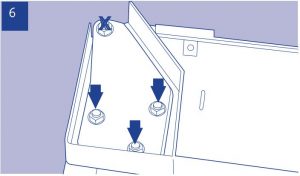
Remove the top hinge bracket by unscrewing the three retaining nuts. DO NOT undo the nut holding the hinge pin. Support the door to avoid damage.
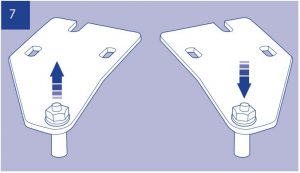
Unscrew and remove the top hinge pin, turn the bracket over and replace it. Tighten securely.
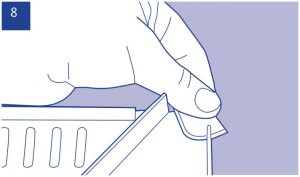
Remove the three screws and the plastic blanking plate and replace them on the opposite side of the cabinet.
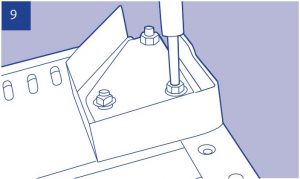
Refit the top bracket fitting the hinge pin, spacers and washers into the bushing at the top of the door. Check the door is aligned correctly before tightening.
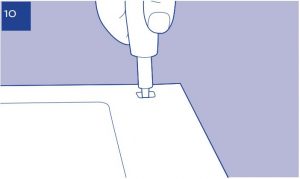
Replace the lid by fitting the front first and sliding into place, securing it with the two screws. Replace the screw covers.

DEFROSTING
After a period of time frost will build up in certain areas in the Freezer compartment. As a temporary measure, this frost should be scraped away using a plastic scraper. NEVER use a metal or sharp instrument. Remove existing foods and baskets, ideally the frozen food should be put into another freezer. Scrape off and remove the frost, then move your foods back in order to gain access to other sections of the Freezer. Complete defrosting will however, become necessary, approximately once a year, or if the frost layer exceeds 4mm to maintain the efficiency of the freezer. This should be carried out if the frost build up cannot be scraped away, or if it begins to interfere with the food storage. Choose a time when the stock of frozen food is low and proceed as follows:
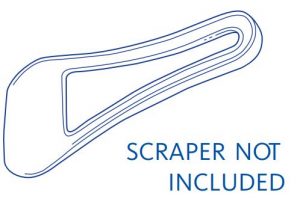
CLEANING
Cleaning inside the FreezerAfter defrosting you should clean the Freezer internally with a weak solution of bicarbonate of soda. Then rinse with warm water using a ‘wrung-out’ sponge or cloth. Wipe the Freezer dry before replacing the baskets and shelves.
Cleaning the outside of the FreezerUse standard furniture polish to clean the Freezer exterior. Make sure that the doors are closed, to prevent polish getting on the magnetic door seal or inside.
The grille of the condenser at the back of the Freezer and the adjacent components can be vacuumed using a soft brush attachment.
Cleaning tip
- Defrost when food stocks are low.
TROUBLESHOOTING
Power cutIf you have a Freezer thermometer, place it in the Freezer where you can get easy access to it to read when the power returns. If the internal temperature is -18°C or less when the power returns, your food is safe. The food in your Freezer will remain frozen for approx 16 hours with the door closed. Don’t open the Freezer doors more than necessary.
The Freezer is not workingCheck it is plugged in and switched on. Check that the fuse in the plug has not blown. Plug in another appliance, such as a lamp, to see if the socket is working.
Condensation appears on the outside of the FreezerThis may be due to a change in room temperature. Wipe off any residue of moisture. If the problem continues call your Customer Service Department.
NoisesYou may hear some unusual noises from time to time. See ‘Noises inside the Freezer’ on page 3
If you are not able to identify and eliminate the faults according to the above recommendations, contact your Authorised Service Agent, advising of model number of the appliance which is shown on the back of the rating plate.
Do not attempt to repair your Freezer yourself as it might endanger you and others.
MAINTENANCE
Moving your FreezerLocationDo not locate your Freezer near a heat source, eg. cooker, boiler or radiator. Also avoid direct sunlight.
Levelling the FreezerMake sure the Freezer is level. Use the rotating levelling feet at the front. If the Freezer is not level, the doors and magnetic seal alignments will be affected.
Do Not Turn on the Freezer for 2 HoursAfter the Freezer is in place it needs to be left for 2 hours. The coolant fluid needs time to settle.
InstallationWarning – do not cover or block the vents or grilles of your appliance.
ServicingRepairs and maintenance should only be performed by a qualified, authorised service engineer
TECHNICAL SPECIFICATIONS
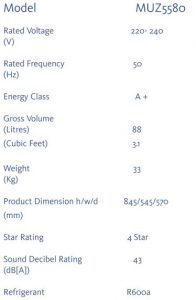
The policy of Fridgemaster is one of continuously seeking new ways of improving its products. Therefore the Company reserves the right to change the speification of items illustrated and described, at any time.
SAFETY
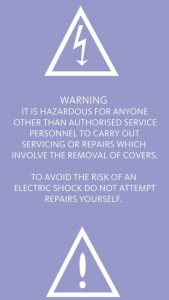
LocksIf your refrigerator is fitted with a lock, to prevent children being entrapped keep the key out of reach and not in the vicinity of the appliance. If disposing of an old refrigerator, break off any old locks or latches as a safeguard.
The appliance was designed and manufactured in compliance with international safety standards. The following warnings are provided for safety reasons and must be read carefully.
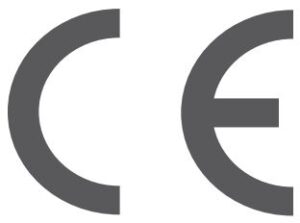
CE marking certifies that this appliance conforms to:Low Voltage Equipment· 73/23/EEC & 93/68EECElectromagnetic Compatibility – 89/336/EEC, 92/31EEC & 93/68EEC
Information concerning disposal
Disposal of packaging
 The packaging protects your appliance from damage during transit. Please contribute to a better environment by disposing of the packaging materials in an environmentally friendly manner.
The packaging protects your appliance from damage during transit. Please contribute to a better environment by disposing of the packaging materials in an environmentally friendly manner.
Observe local environmental standards when disposing of packaging material for recycling purposes.
Please ask your dealer or inquire at your local authority about current means of disposal.
Keep packaging materials out of the reach of children! It can become a choking or suffocation hazard.
Disposal of your old appliance Old appliances are not worthless rubbish! Recycling old appliances can reclaim valuable raw materials.
Old appliances are not worthless rubbish! Recycling old appliances can reclaim valuable raw materials.
 This appliance has been identified in accordance with the European directive 2002/96/EC on Waste Electrical and Electronic Equipment – WEEE.
This appliance has been identified in accordance with the European directive 2002/96/EC on Waste Electrical and Electronic Equipment – WEEE.
The directive requires that old household electronic appliances must not be disposed of in the normal unsorted municipal waste stream. Old appliances must be collected separately in order to optimise the recovery and recycling of the materials they contain and reduce the impact on human health and the environment. The crossed out “wheeled bin” symbol on the product reminds you of your obligation, that when you dispose of the appliance it must be separately collected.
Consumers may take their old appliances to public waste collection areas, other communal collection areas, or if national legislation allows return it to a retailer when purchasing a similar new product.
Old appliances still have some residual value. An environmentally friendly method of disposal will ensure that valuable raw materials can be recovered and used again. The refrigerant used in your appliance and insulation materials require special disposal procedures. Ensure that none of the pipes on the back of the appliance are damaged prior to disposal. Up to date information concerning options for disposing of your old appliance and packaging from the new one can be obtained from your local council office.
Redundant appliances:Cut off the mains plug and discard it. Refrigerators contain refrigerants and the insulation contains gases. Refrigerant and gases must be disposed of properly.
Ensure the tubing of the refrigerant circuit is not damaged prior to proper disposal.
Safety and warning information
Before you switch ON the appliancePlease read the operating and installation instructions carefully. They contain important information on how to install, use and maintain the appliance. Keep all documentation for subsequent use or for the next owner.
Technical safetyThis appliance contains a small quantity of environmentally friendly but flammable R600a refrigerant. Ensure that the tubing of the refrigeration circuit is not damaged during transportation and installation. Leaking refrigerant may ignite.
If damage has occurred
- Keep naked flames and/or ignition sources away from the appliance.
- Pull out the mains plug.
- Thoroughly ventilate the room for several minutes.
- Notify customer services.
The more refrigerant an appliance contains, the larger the room must be. Leaking refrigerant can form a flammable gas-air mixture in rooms which are too small. The room must be at least 1m3 per 8 g of refrigerant. The amount of refrigerant in your appliance is indicated on the rating label on your appliance.
Important information when using the appliance
- This appliance is not intended for use by persons (including children) with reduced physical, sensory or mental capabilities, or experience or knowledge, unless they have been given supervision or instructions concerning the use of the appliance by a person responsible for their safety. Children should be supervised to ensure that they do not play with the appliance.
- If the supply cord is damaged, it must be replaced by the manufacturer, its service agent or similarly qualified persons in order to avoid a hazard.
- Never use electrical appliances inside the refrigerator (e.g. heater, electric ice maker, etc.). Explosion hazard!
- Never use a steam cleaner to clean the appliance. The steam may penetrate electrical parts and cause a short circuit. Risk of electric shock!
- Do not store products which contain flammable propellants (e.g. spray cans) or explosive substances in the appliances. Explosion hazard!
- Do not stand or support yourself on the base, drawers or doors, etc.
- Before defrosting and cleaning the appliance, pull out the mains plug or switch off the fuse. Do not pull out the mains plug by tugging the cable.
- Commercially frozen pre-packed food should be stored in accordance with the frozen food manufacturers instruction.
- Bottles containing a high percentage of alcohol must be sealed and stored in an upright position.
- Keep plastic parts and the door seal free of oil and grease. Otherwise, the plastic and door seal will become porous.
- Never cover or block the ventilation openings for the appliance.
- Do not store bottled or canned drinks (especially carbonated drinks) in the ice compartment. Bottles and cans may explode!
- Never put frozen food, or ice cubes, straight from the ice compartment into your mouth. Risk of frost burns to the lips and tongue!
- Avoid prolonged touching of frozen food, ice or the inner freezer walls or tubing etc. Risk of frost burns to the skin.
- Do not scrape off frost or stuck frozen food with a knife or pointed object. You could damage the refrigerant tubing. Leaking refrigerant may ignite. Only use a plastic scraper.
- In the case of malfunction, under no circumstances should you attempt to repair the appliance yourself. Repairs carried out by inexperienced persons may cause injury or further malfunctioning to the appliance.
- When the appliance is unplugged please wait for 5 minutes before plugging it in again. Otherwise, the compressor will be overloaded.
- Do not use electrical appliances such as a hairdryer or heaters near your refrigerator.
- Do not store inflammable gases or liquids inside your refrigerator.
Children in the household
- Keep children away from the packaging and its parts. Danger of suffocation from folding cardboard and plastic film!
- Do not allow children to tamper with the controls or play with the appliance. It is not a toy. Under no circumstances should children be allowed to sit on the bins or hang from the door.
- If the appliance features a lock, keep the key out of the reach of children.
General requirements
- The appliance is designed for domestic use inside the home and is not intended for commercial or industrial use.
- The appliance must be used to store food products by adults only and according to the instruction manual.
- Try to avoid keeping the door open for long periods or opening the door too frequently in order to conserve energy.
- Do not fill the appliance with too much food: cold air must circulate freely for food to be preserved properly.
ELECTRICAL CONNECTIONS
THIS APPLIANCE MUST BE EARTHED.This appliance is fitted with a fused three pin plug to BS 1363 which will be suitable for use in all houses fitted with sockets to current specifications.
If the fitted plug is not suitable for your socket outlets, it should be cut off and carefully disposed of. To avoid a possible shock hazard, do not insert the discarded plug into a socket.
Fitting a new plugIf for any reason you need to fit a new plug, the flexible mains lead must be connected as shown here.
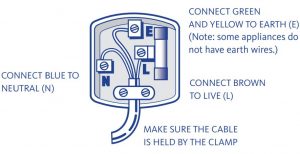
The wires in the mains lead fitted to this appliance are coloured in accordance with the following code:
If the colours of the wires in the mains lead of this appliance do not correspond with the coloured markings identifying the terminals in your plug, proceed as follows:
The wire which is coloured Green and Yellow MUST be connected to the terminal which is marked with the letter E (Earth) or symbol or coloured Green. The wire which is colour ed Blue MUST be connected to the terminal which is marked with the letter N or coloured Black. The wire which is coloured Brown MUST be connected to the terminal which is marked with the letter L or coloured Red.
Before refitting the plug cover, check that there are no cut or stray strands of wire inside the plug.
Use a 13 Amp BS1362 fuse, only BSI or ASTA approved fuses should be used. If you are in any way unsure which plug or fuse to use, always refer to a qualified electrician.
Note: After replacing or changing a fuse on a moulded plug which has a fuse cover, the cover must be refitted to the plug, the appliance must not be used without a fuse cover. If lost, replacement fuse covers can be obtained from an electrical shop.
This appliance complies with the following EEC Directives: 73 / 23 EEC (Low Voltage Directive) 89 / 336 EEC (EMC Directive).
FRIDGEMASTERUnit D, Global AvenueGlobal Park Millshaw, Leeds LSll 8PR Tel: +44(0) 113 395 6930Fax: + 44(0) 113 270 8599
For further information please contact the Fridgemaster Technical Helpline on: 0845 0508536
 This symbol on the product or in the instructions means that your electrical and electronic equipment should be disposed at the end of its life separately from your household waste. There are separate collection systems for recycling in the EU.
This symbol on the product or in the instructions means that your electrical and electronic equipment should be disposed at the end of its life separately from your household waste. There are separate collection systems for recycling in the EU.
For more information, please contact the local authority or your retailer where you purchased the product.
Fridgemaster MUZ5580 Freestanding Under Counter Freezer User Manual – Fridgemaster MUZ5580 Freestanding Under Counter Freezer User Manual –
Questions about your Manual? Post in the comments!
[xyz-ips snippet=”download-snippet”]

